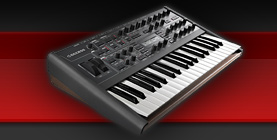

|
|||||||
| Sound designing Discussion about sound designing with the Virus series synths. Share patches and your knowledge or ask questions. |
 |
|
|
Thread Tools | Search this Thread | Display Modes |
|
#1
|
|||
|
|||
|
Nebody know of a good plug-in sequencer I can use in cubase sx that is easy to use like the matrix in Reason. I find it takes me forever to draw & change patterns in cubase. Or is there another solution I should look for.
__________________
"you are a true believer......" THX1138 |
|
#2
|
||||
|
||||
|
have a look for the list of shortcuts in the cubase manual! You can do it all without even touching your mouse which is quite fast IMO.
Also, try to use the midi plugins bundled in cubase, there is a few regarding sequencing(midi gate is really useful). If you liked the matrix in Reason, you can have a look for Reaktor which has something really similar
__________________
http://www.madstation.net/ |
|
#3
|
|||
|
|||
|
Thanx madstation. I have tried using the step sequencer in cubase & I just can't get comfortable with it compared to the matrix. I will look up come short keys butt I don't think it is what I'm looking for in regards to using a sequencer like the matrix. I can't afford reactor either.
__________________
"you are a true believer......" THX1138 |
|
#4
|
||||
|
||||
|
Hehe, you need a modern old-skool Tracker.
www.Renoise.com www.Skale.org www.FastTracker2.com www.MadTracker.org Immense multi-channel step sequencers, with inbuilt multi-samplers to boot, and also include ASIO and VST integration. If only Renoise' midi timing on PC was tighter I wouldn't use any other sequencer.
__________________
PS > And another thing! Will the Ti|3 have user customisable/importable wavetables? |
|
#5
|
|||
|
|||
|
Thanx Timo that sounds like what I am looking for..
__________________
"you are a true believer......" THX1138 |
|
#6
|
||||
|
||||
|
Quote:
It's what they used in the old days to program proper, old-skool DnB breaks and stuff. Try to do that in Cubase with your mouse etc,. and it's overtly painstaking and damn hard.
__________________
PS > And another thing! Will the Ti|3 have user customisable/importable wavetables? |
|
#7
|
|||
|
|||
|
which one do you suggest? I see fasttracker3 up there. What is the dif. between fastrack & madtrack? I do alot of dnb style drum programming as well & I have heard about this butt it sounded like a big learning curve. I know Sound Murderer uses fasttracker & has written his own version of the program. I guess that is why it scares me because it sounds like you need to be a programmer to figure it out.
__________________
"you are a true believer......" THX1138 |
|
#8
|
||||
|
||||
|
Quote:
Instead of normal sequencers that scroll left to right on playback, trackers scroll top to bottom (vertically). A "track" is the same as a "channel", by the way. Each main column is therefore a "track". And each row is a "step" (a regular period in time, such as an 8th of a bar, or 16th, or 32nd, or whatever you've set your tempo to be, depending on how complex you wish the song structure to be). The rows are effectively quantise points, and the sequencer will trigger your audio samples in series as each row is passed in time when played back, just like a normal step sequencer. Load up a single sample (or multisample) into a free slot, then use your keyboard (or computer typing keyboard) to place the sample at whatever pitch you want on whatever rows you want the sample to be re-triggered. That's pretty much it! When you play back the song the samples will be triggered as the song pointer moves downwards and passes over a row with a sample placed on it. So if you want a standard 4/4 kick drum, place the kickdrum every 8 rows or so (for example row numbers: 0, 8, 16, 24, 32, etc.), and then set your tempo accordingly. Then you can put the snare in between (say on rows 4, 12, 20, etc.), and then you can place the hihats inbetween the kick and the snares (such as on rows 2, 6, 10, 14, 18, etc.). Voil?.
__________________
PS > And another thing! Will the Ti|3 have user customisable/importable wavetables? |
 |
«
Previous Thread
|
Next Thread
»
| Thread Tools | Search this Thread |
| Display Modes | |
|
|
 Similar Threads
Similar Threads
|
||||
| Thread | Thread Starter | Forum | Replies | Last Post |
| MATRIX | Guzzy | General discussion about Access Virus | 16 | 22.03.2006 07:39 PM |
| Musical Style and Creativity | pseudonym | General discussion about music | 2 | 20.11.2005 07:01 PM |
| MOD MATRIX | technomonster | General discussion about Access Virus | 2 | 19.04.2005 04:24 PM |
| 80's style sounds? | DIGITAL SCREAMS | Sound designing | 15 | 12.01.2005 08:47 PM |
All times are GMT. The time now is 08:54 PM.
Powered by vBulletin® Version 3.6.4
Copyright ©2000 - 2025, Jelsoft Enterprises Ltd.
Skin Designed by: Talk vBulletin
Copyright ©2000 - 2025, Jelsoft Enterprises Ltd.
Skin Designed by: Talk vBulletin
Copyright ©2002-2022, Infekted.org
 |
 |









 Linear Mode
Linear Mode

